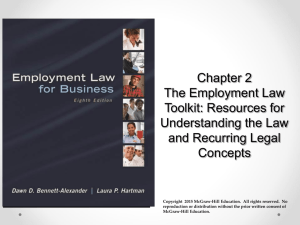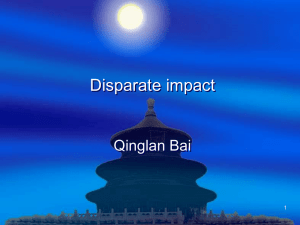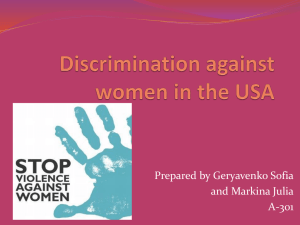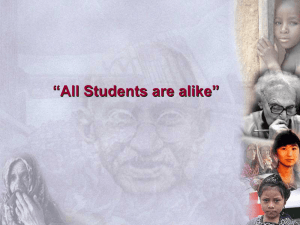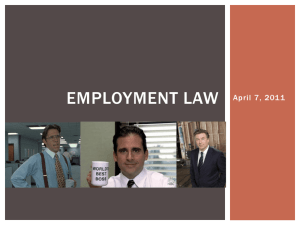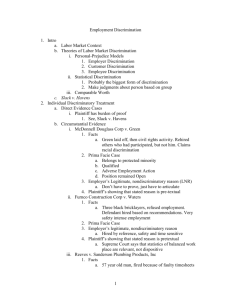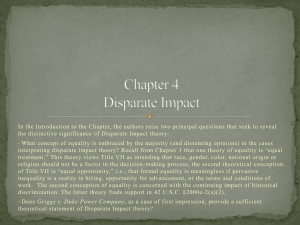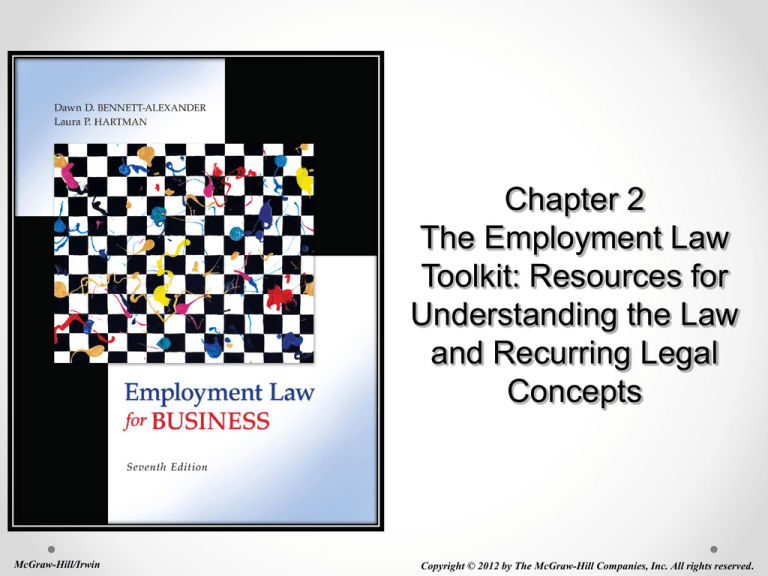
Chapter 2
The Employment Law
Toolkit: Resources for
Understanding the Law
and Recurring Legal
Concepts
McGraw-Hill/Irwin
Copyright © 2012 by The McGraw-Hill Companies, Inc. All rights reserved.
Learning Objectives
Understand how to read and digest legal cases
and citations
Explain and distinguish the concepts of stare
decisis and precedent
Evaluate whether an employee is an at-will
employee
2-2
Learning Objectives
Determine if an at-will employee has sufficient
basis for wrongful discharge
Recite and explain at least three exceptions to
employment-at-will.
Distinguish between disparate impact and
disparate treatment discrimination claims
2-3
Learning Objectives
Provide several bases for employer defenses to
employment discrimination claims
Determine if there is sufficient basis for a
retaliation claim by an employee
Identify sources for further legal information and
resources
2-4
Stare Decisis and Precedent
Stare decisis
A system of using legal precedent
Federal court system
U.S. Court decisions applicable in all jurisdictions
Circuit court decisions applicable only in that
particular circuit
District court decisions applicable only in that
particular district
2-5
Stare Decisis and Precedent
State court system
Trial court intermediate court of appeals state
supreme court
State supreme court decisions can be appealed
to the U.S. Supreme Court
U.S. Supreme Court decisions are final
2-6
Understanding the Case Information
Key Terms
Meaning
Plaintiff
One who brings a civil action in court
Defendant
One against whom a case is brought
Appellant
One who brings an appeal
Appellee
One against whom an appeal is brought
Petitioner
One who appeals a case to the Supreme Court
Respondent
One against whom a case is appealed at the Supreme
Court
2-7
Understanding the Case Information
Key Terms
Meaning
Case citation
The several number and a few letter under the case
name
Motion to
dismiss
Request by defendant for court to dismiss plaintiff’s
case
Motion for
summary
judgment
Defendant’s request for the court to rule on plaintiff’s
case based on the documents submitted, alleging
there are no tribal issues of fact to be decided
Per curium
A brief decision made by the court
2-8
Prima Facie Case
Cause of action: Right provided by law for a
party to sue for remedies when that right is
violated
Prima facie case: Presenting evidence that fits
each requirement of a cause of action
2-9
Employment-at-Will Concepts
At-will employment: Employment relationship
where there is no contractual obligation to
remain in the relationship
Exclusions
Government employees
Employees under a collective bargaining agreement
Employees under individual contract with employer
2-10
Employment-at-Will Concepts
Title VII of the Civil Rights Act of 1964
Age Discrimination in Employment Act
Americans with Disabilities Act
Wrongful termination
Employees may seek reinstatement or compensatory
and punitive damages for the any losses suffered
2-11
Exceptions to the At-Will Doctrine
Bad faith, malicious, or retaliatory termination
may serve as a violation of public policy
Termination in breach of the implied covenant of
good faith and fair dealing
Termination in breach of some other implied
contract term
Termination in violation of the doctrine of
promissory estoppel
2-12
Violation of Public Policy
Public policy: Legal concept intended to ensure
that no individual lawfully do that which has a
tendency to be injurious to the public or against
the public good
Whistle-blowing
Federal Whistleblower Statute
Whistleblowers Protection Act
State protection
2-13
Retaliatory Discharge
Terminations in response to an employee
exercising rights provided by law
Constitutional protections
An employer is prohibited from terminating a worker
or taking other adverse employment action against a
worker on the basis of the worker’s engaging in
constitutionally protected activities
Applies only where the employer is a public entity
2-14
Retaliatory Discharge: Prima Facie
Case
Participation in a
protected activity
An adverse
employment action
Causal connection
between the protected
activity and the
adverse action
Burlington Northern & Santa Fe Railway Co. v.
White
2-15
Breach of Implied Covenant of Good
Faith and Fair Dealing
Covenant of good faith and fair dealing:
Implied contractual obligation to act in good faith
in the fulfillment of each party’s contractual
duties
A breach of implied covenant of good faith looks
to the actions between the parties to ascertain
whether there were any violations of public
policy
2-16
Breach of Implied Contract
Implied contract: An unexpressed contract that
is created by words or conduct of the parties
involved
Melott v. ACC Operations, Inc.
2-17
Promissory Estoppel: Prima Facie
Case
The employer
made a promise
On which the
worker
reasonably
relied
To the
employee’s
detriment
Exceptions to at-will doctrine based on
promissory estoppel
Statutory Exceptions to employment at-will
Occupational Safety and Health Act
Fair Labor Standards Act
Pregnancy Discrimination Act
2-18
Constructive Discharge
Constructive discharge: Occurs when the
employee is given no reasonable alternative but
to end the employment relationship
Considered an involuntary act on the part of the
employee
Paloni v. City of Albuquerque Police Department
Nassar v. Univ. of Texas Southwestern Medica
Center at Dallas
2-19
Other Exceptions to At-Will Doctrine
The Worker Adjustment and Retraining
Notification Act (WARN)
Requires that employers with over 100 employees
must give 60 days’ advance notice of a plant closing
or mass layoff to affected employees
2-20
Other Exceptions to At-Will Doctrine
Wrongful Discharge Based on Other Tort Liability
Tort of outrageous conduct
Tort claim for emotional distress
Tort action of defamation
Wrongful invasion of privacy
2-21
Disparate Treatment Discrimination:
Prima Facie Case
Employee belongs to a class
protected under Title VII
Employee applied for and was qualified for a job
for which the employer was seeking applicants
Employee was rejected and, after the rejection, the position
remained open
Employer continued to seek applicants with the rejected
applicant’s qualifications
2-22
Employment Discrimination Concepts:
Disparate Treatment
Disparate treatment: Treating similarly situated
employee differently because of prohibited Title
VII factors.
2-23
Employment Discrimination Concepts:
Disparate Treatment
Employer’s defense
Legitimate, Nondiscriminatory Reason Defense
Employee’s counter – legitimate, nondiscriminatory reason is
a mere pretext for the employer to discriminate.
The Bona Fide Occupational Qualification
Defense: Permissible discrimination if legally
necessary for employer’s particular business
Wilson v. Southwest Airlines Company
2-24
Employment Discrimination Concepts:
Disparate Impact
Disparate impact: Deleterious effect of a
facially neutral policy on a Title VII group
Facially neutral policy: Workplace policy that
applies equally to all appropriate employees
Griggs v. Duke Power Co.
Wards Cove Packing Co. v. Atonio
2-25
Employment Discrimination Concepts:
Disparate Impact
Screening device: Factor used to weed out
applicants from the pool of candidates
Four-fifths rule: Minority must do at least 80
percent (four-fifths) as well as majority on
screening device or presumption of disparate
impact arises
Device must be shown to be a legitimate business
necessity
Subjective and objective criteria
2-26
Employment Discrimination Concepts:
Disparate Impact
Pre-employment interviews
Employment applications
The business necessity defense: Defense to a
disparate impact case based on the employer’s
need for the policy as a legitimate requirement
for the job
2-27
Other Defenses to Employment
Discrimination Claims
The employee’s evidence is not true
The employer’s “bottom line” comes out
correctly
Connecticut v. Teal
2-28
Accommodation
Religious discrimination under Title VII
Americans With Disabilities Act (ADA)
Conditions for religious accommodation and
accommodation of those with disabilities differ
Exhaustion of Administrative Remedies:
Going through the EEOC administrative
procedure before being permitted to seek
judicial review of an agency decision
2-29
Exhibit 2.9 - Employment Discrimination
Remedies
2-30
Employment Discrimination Remedies
Key Terms
Meaning
Back pay
Money awarded for time employee was not working
because of illegal discrimination
Front pay
Equitable remedy of money awarded to claimant
when reinstatement is not possible or feasible
Retroactive
seniority
Seniority that dates back to the time the claimant
was treated illegally
2-31
Employment Discrimination Remedies
Key Terms
Meaning
Make-whole
relief
Attempt to put the claimant in position he or she
would have been in had there been no
discrimination
Compensatory Money awarded to compensate the injured party for
damages
direct losses
Punitive
damages
Money over and above compensatory damages
2-32
Legal Resources
Law libraries
Law reporters
Law journals
Legal treaties
Books and other legal resources
The Internet
2-33
Management Tips
Employers are always allowed to hire the best
person for a job
Policies and procedures must have space for
employees to voice their concerns and
complaints
Firing must not be due to specific reasons
prohibited by law
Employees reporting wrongdoings must not face
retaliation from their employers
2-34
Management Tips
Termination decisions should undergo internal
review
Employees belonging to a protected must be
made aware of their rights
Employees pursuing legally protected rights
must not face retaliation
Certain protected categories must be
accommodated
2-35

